The role of a target man may be something we see less and less of in top-tier football these days, but it stands the test of time in EFL, with several teams effectively utilising a big, physical centre forward as a critical element of their attacking tactics.
Possibly the most effective and dangerous target man this season in England (so far) has been Salford City’s Matt Smith. While the League Two club sit 13th after a mixed start to the campaign, their attacking output has been promising, and they have some strong tactical checkpoints in their identity.
This scout report will provide a tactical analysis of Smith’s role in Salford’s tactics, with the analysis viewing key areas of contribution so far this season. Specifically, we will analyse how he interacts with the midfield unit in transitions and build-up phases while also looking at the threat he poses inside the penalty box – from both open play and set-pieces.
Salford’s attack – a brief overview
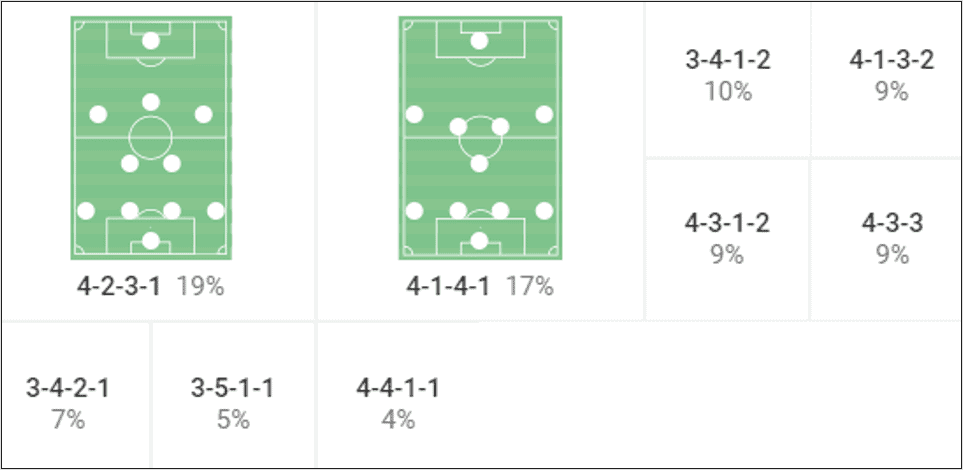
Neil Wood, who has been the club’s first-team manager since May 2022, has been seen to deploy a variety of formations, all of which lend themselves to providing attacking support for Matt Smith, whether he plays a lone forward or with a partner up top. Their most common shape has been 4-2-3-1, where Smith receives a lot of central support from the attacking midfielder.
While they are highly successful with long passes, with 57.8% of their attempts being accurate (the highest rate in the league), they also have one the lowest attempt rates, averaging just 48.96 long passes per 90. This may surprise some, with the assumption being that they like to fire long balls up to Smith, but, as this scout report will explain, that is rarely the case.
In terms of utilising Smith in possession, we will go into more detail shortly, but he likes to drop into midfield areas to support build-up phases – a vintage move for a big centre forward, rather than making runs in behind the defence. Once in possession himself, Smith looks to quickly move the ball on, often out to wide support.
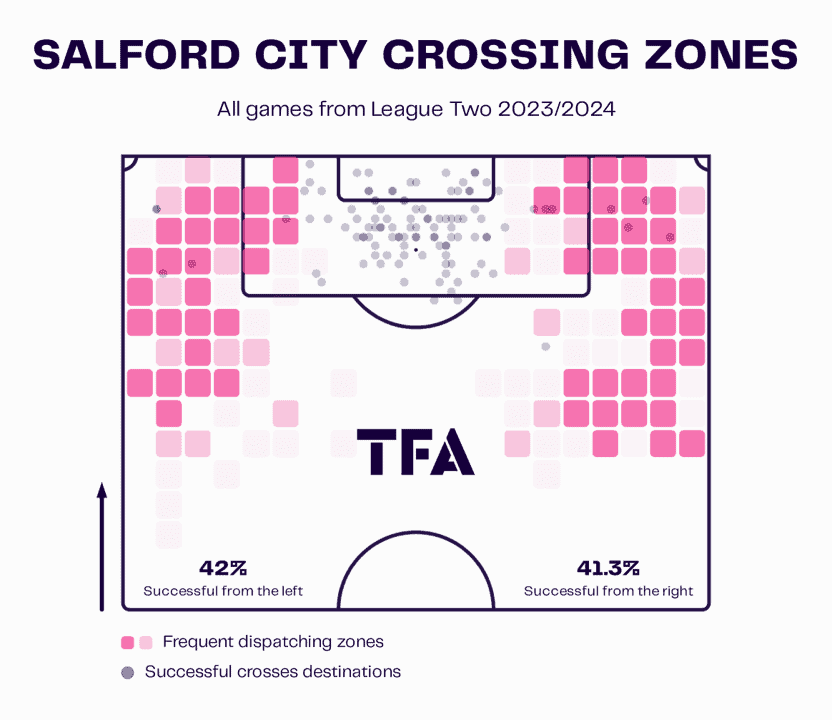
Another assumption that some may make for a team that utilises a physical forward is that they hit cross after cross, game in, game out, but at the time of writing, Salford’s rate of 15.13 crosses per 90 falls below the league average – low averages for both long passes and crosses: an insight into the unique deployment of a target man.
While they don’t rely on crosses all the time, they do favour attacking down the right flank, as the frequency levels on the crossing map above shows. Additionally, while the success rates between the two flanks has very little between them, Salford have so far made 154 crosses from the right – just 117 from the left.
Smith’s role – linking with midfield
As we touched upon earlier, Smith has the tendency to drop in deep to support build-up phases for Salford, something he has done throughout his career, in fact, including during his time in the Championship. Now a seasoned veteran, he has even more know-how of where and when to effectively support the midfield unit in trying to move possession into a more dangerous area.
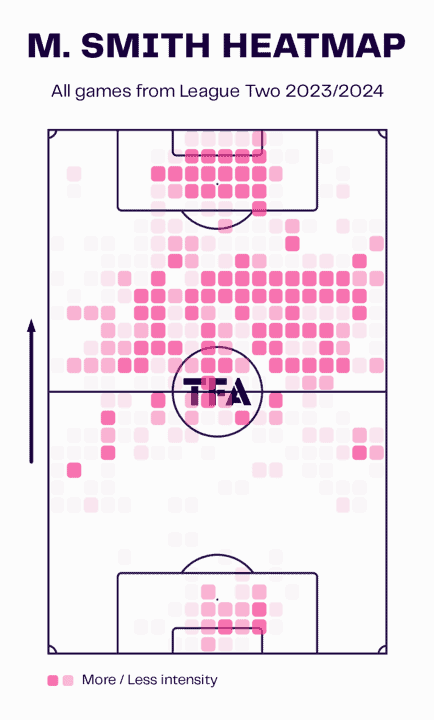
As his heatmap shows, he is very much a central player, with minimal activity in wide areas, something that should not come as a shock regarding a target forward. While he unsurprisingly is frequently involved inside the box, as you can see, he is also involved frequently in midfield areas as Salford look to break into the opposition half/final third. Interestingly, however, he is rarely involved in play around the edge of the box – more insight into where he likes to lend his assistance.
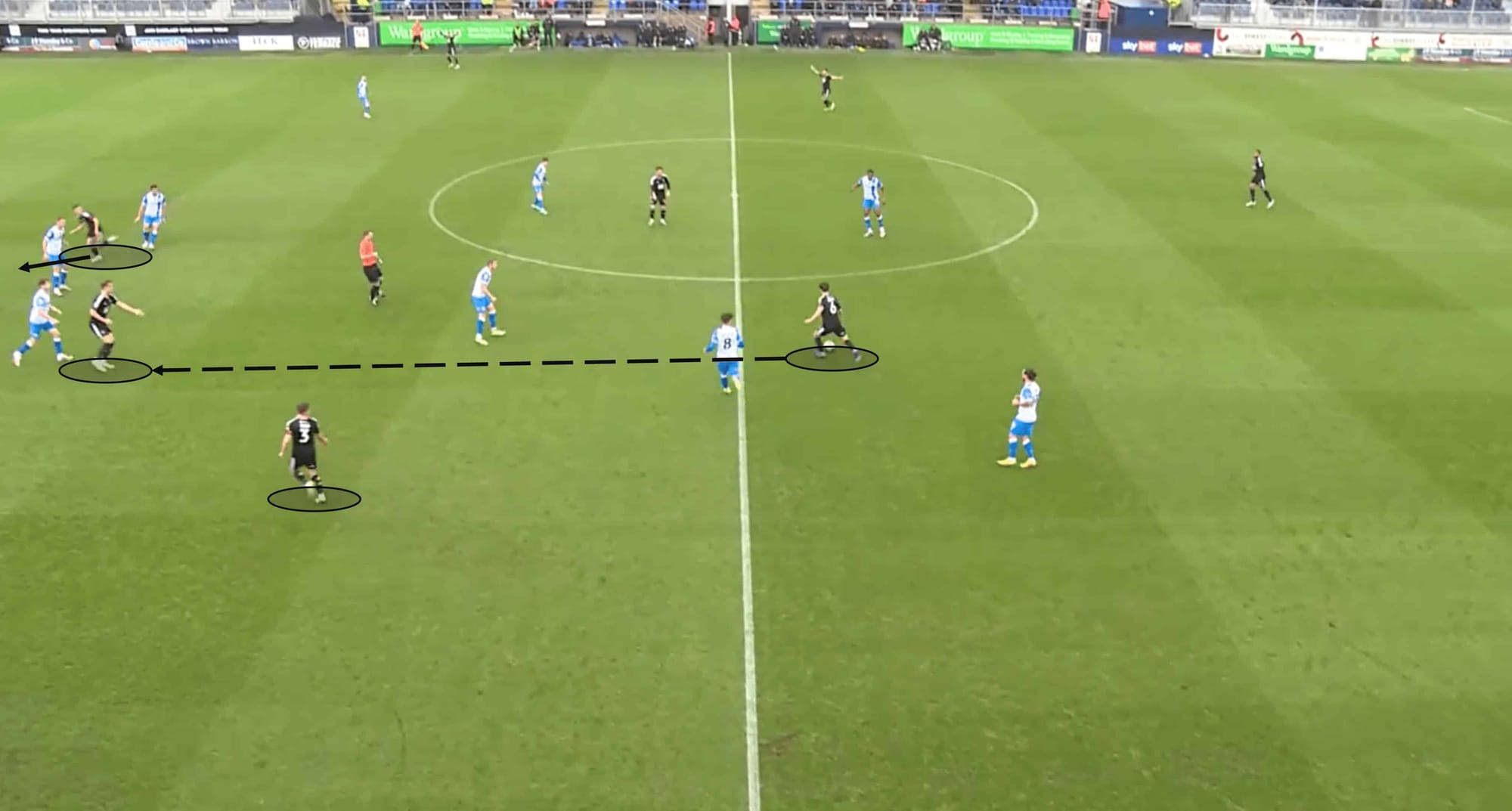
While Smith does like to drop into supporting positions, he does so in varying ways and positions. In this first example, for instance – he drops slightly deeper with the aim of dragging his marker with him, opening up the space for his teammate to run into. His positioning still offers good support for the man on the ball, with passes through the centre into Smith being a crucial part of Salford’s tactics.
This particular example did not pan out for Salford, but had the ball reached Smith’s complete control; he would have likely bounced the pass to the highlighted number three before making his way to the box.
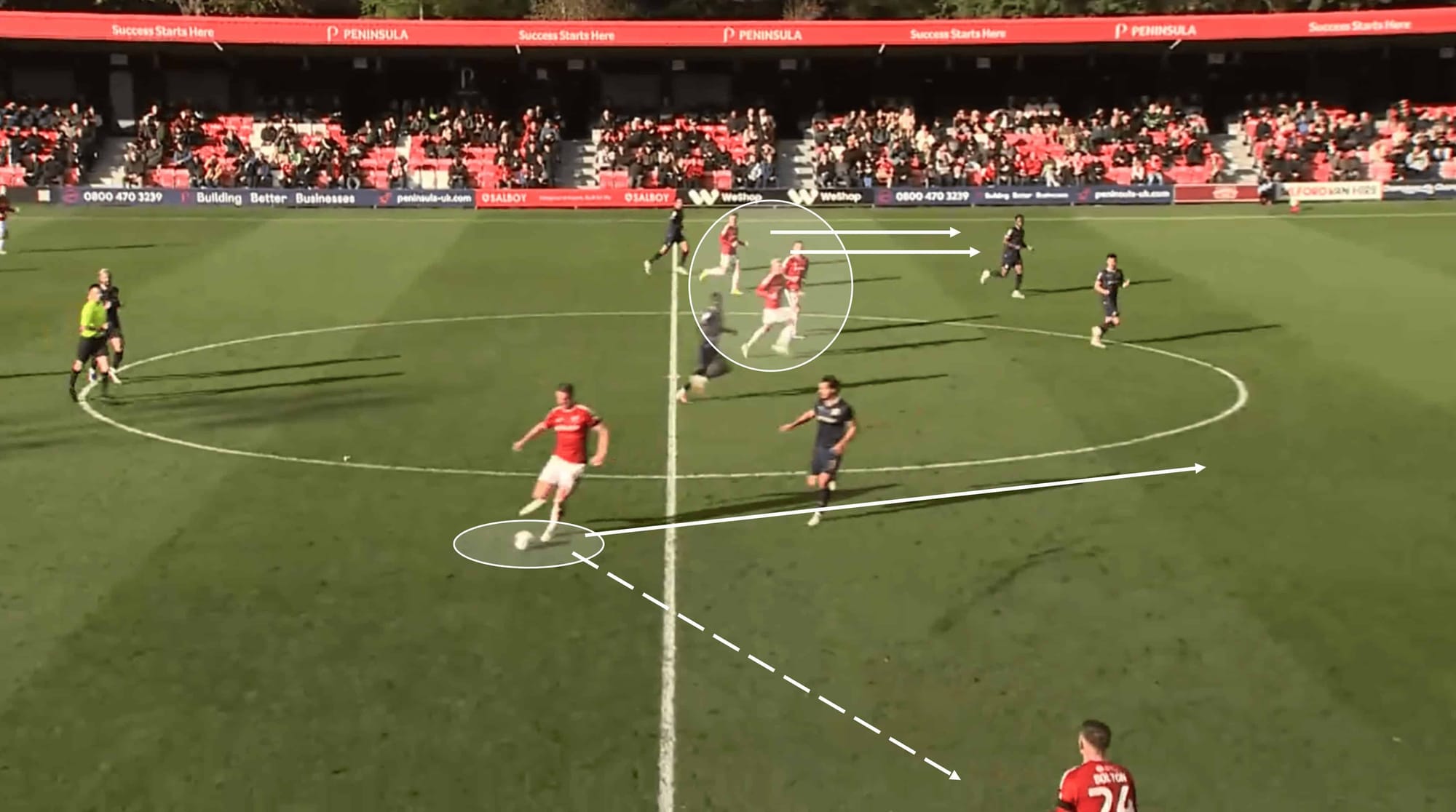
His tendency to drop into midfield zones massively lends itself to Salford’s ability to attack in transitions smoothly – or simply move comfortable possession into a more attacking area. While Smith isn’t the quickest due to his size, his deeper positioning can be challenging to mark as opposition defenders are understandably reluctant to leave their post to mark Smith. Additionally, the midfielders may miss the queue to pick him up as they got sucked into marking one of the many runners in the Salford attack.
Smith’s role once he gets the ball is again to quickly relay the ball, often out to wide support, especially if the space is there, as it is in the example above. He then gives his all to get to the box as quickly as he can, but Salford have been seen to hold onto the ball and slow things down to give him a chance to get into a strong position inside the box before whipping a cross in.
Smith also offers variety in these areas, particularly in the sense that he can collect ground passes comfortably while holding off opposition challenges. Still, he can also use his aerial ability to either bring the ball down or flick it on to a teammate.
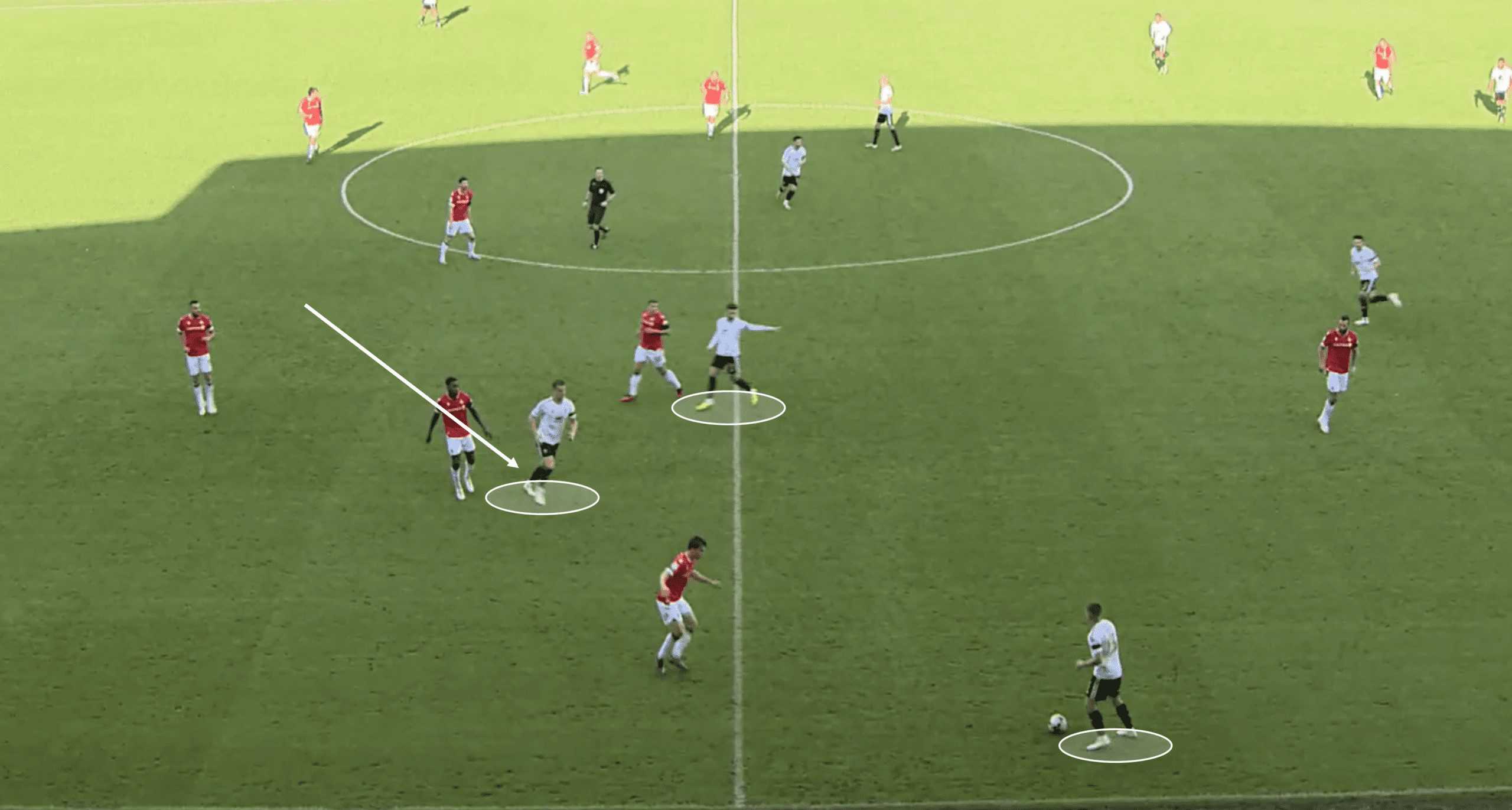
Another use of his deep positioning is to offer general possession support, effectively becoming an extra midfield player in these cases. This move lends itself to any formation Salford set up with and involves Smith coming slightly wider than his usual central position to offer close support to the full/wing back or the winger, often with another midfielder or two close by.
In these scenarios, Smith doesn’t usually make an instant run toward the box as his team are not yet in a position to launch the attack. Instead, his positioning reflects that of Salford’s – if the possession stays on the same side, he will continue to act as close support, but if they move the ball across the pitch (a move which often forces the opposition back, allowing Salford forward as they are attacking space), Smith starts to return to a more central location before making his next move, again dependent on Salford’s possession.
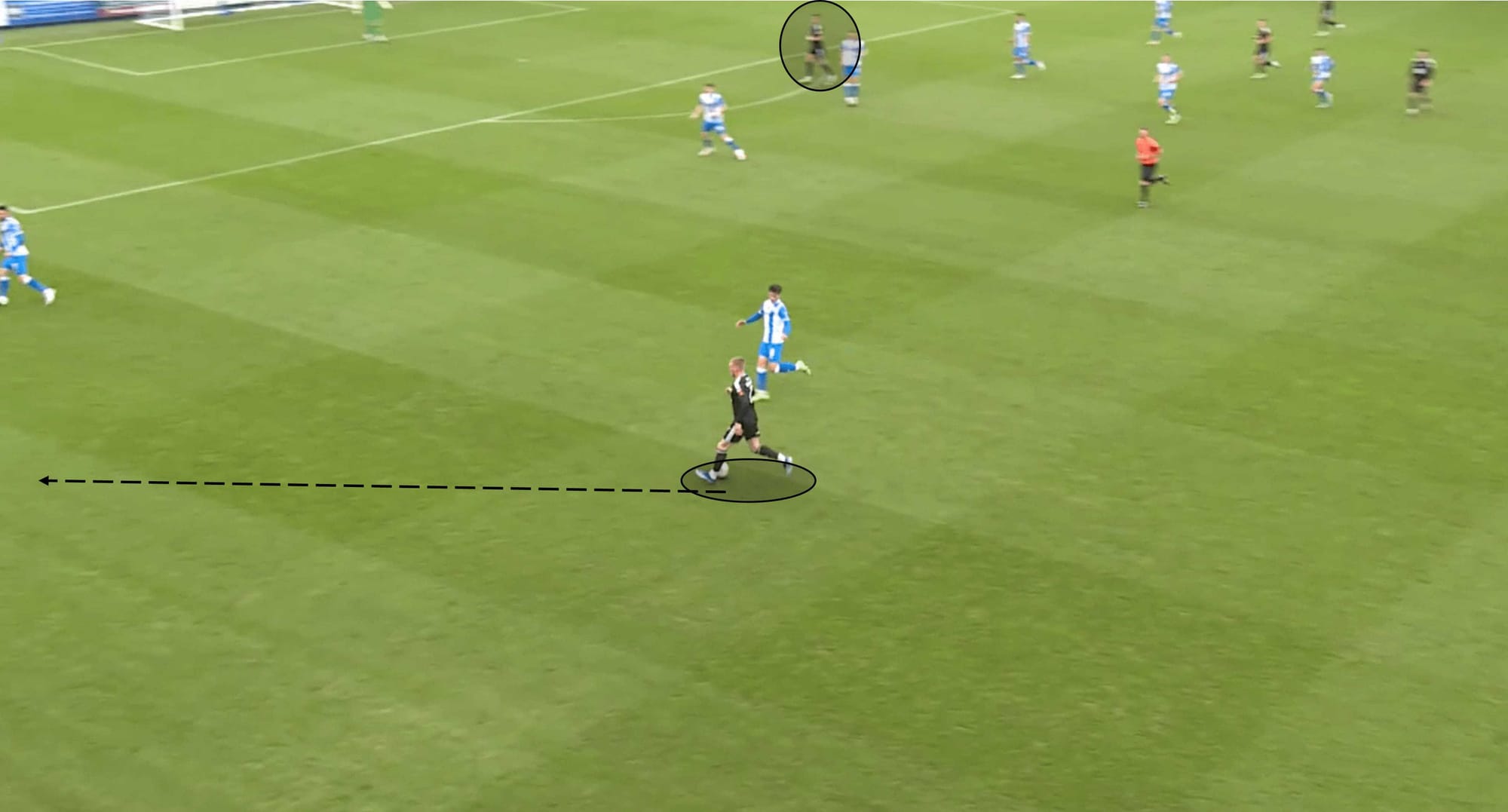
You might have picked up on this already, but Matt Smith’s positioning and off-the-ball movement can tell his Salford teammates what to do next, effectively acting as a method of communication, a trigger. For instance, the image above shows Smith edging forward but in an offside position. This is something Smith tends to do when he thinks his team can work the ball into a wide area and deliver a cross – it tells them that he isn’t interested in playing the support role at that moment but instead that he wants to attack.
Dangerous presence in the box
While he is an effective team member in terms of assisting possession, at the end of the day, Matt Smith is a striker and will ultimately be judged on his goalscoring ability. This season that has not been an issue for the big man at all, so far bagging 12 league goals – making him the top scorer in England’s top four tiers, ahead of a few high-profile names in second, including Manchester City star Erling Haaland. Here, we analyse Smith’s activity in the box – why he has been so dangerous for Salford from both open play and from corners.
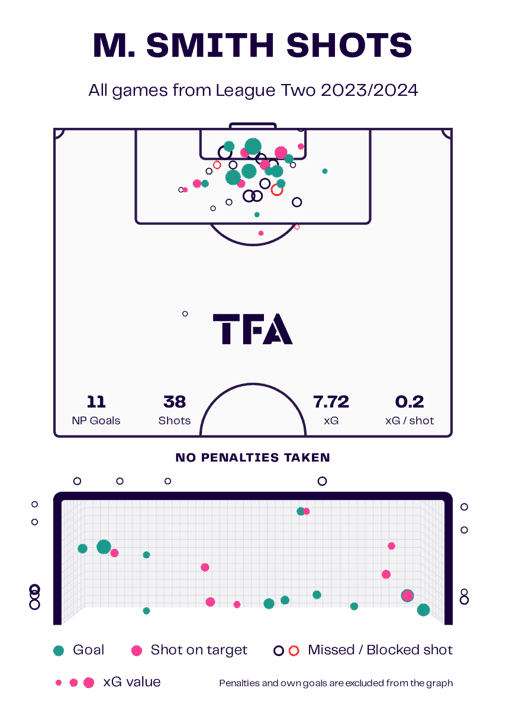
11 of Smith’s 12 goals in League Two this season have been non-penalty goals, and a lot of them are a result of the former Leeds United forward utilising his physicality in the box to win various duels. As shown in his shot map above, he rarely takes aim from outside the box, working his magic within 18 yards. This is down to the fact that his role in the final third involves less link-up with the midfield, as we saw earlier, and more simply being on the finishing end of the move, as a target man should be.
Breaking down where his goals come from – six are headed goals – the highest tally in the EFL at the time of writing. He has also scored from three corners, which is also the EFL’s highest individual tally. This is where we start to really see why Smith is a good fit for Salford’s tactics – the Ammies have scored eight headed goals all in all this season and seven goals from corners – both of those numbers are the highest in League Two.
Another additional element of Smith’s attacking output is how he outperforms his xG, which currently stands at 7.72, quite some way below his goal tally. This could indicate Smith’s ability to score from unlikely situations – we have seen some evidence of this in aerial duels in the box, as well as reacting quickly to get on the end of opposition mistakes in critical areas.
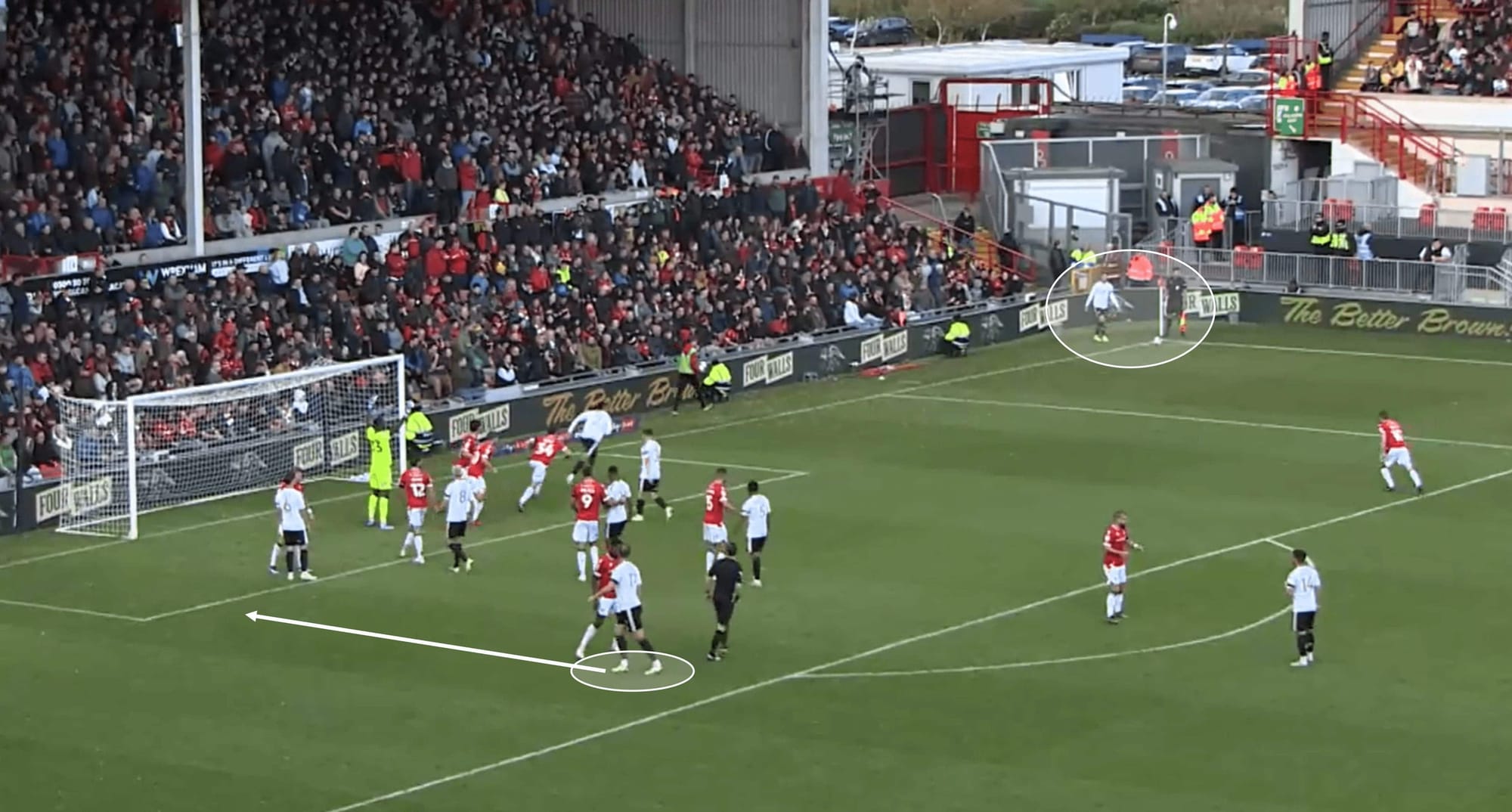
While we have seen Smith take up several positions and runs from corners this season, his most frequent and arguably his most effective is the one you see above – starting near the edge of the box and peeling away towards the far side of the box. Suppose the delivery does reach him in these scenarios. In that case, his immense power and aerial ability help him direct a header towards goal, but he also can cushion the ball back across the goal into a dangerous area. Alternative moves from him at corners include starting at the near post and looking to flick the ball on or simply being in the mix of things in the middle of the six-yard box.
Standing at a towering 6 ft 5, Smith is already at an advantage for aerial duels – his muscular physique and good physical attributes only strengthen that advantage when it comes to challenging in the air.
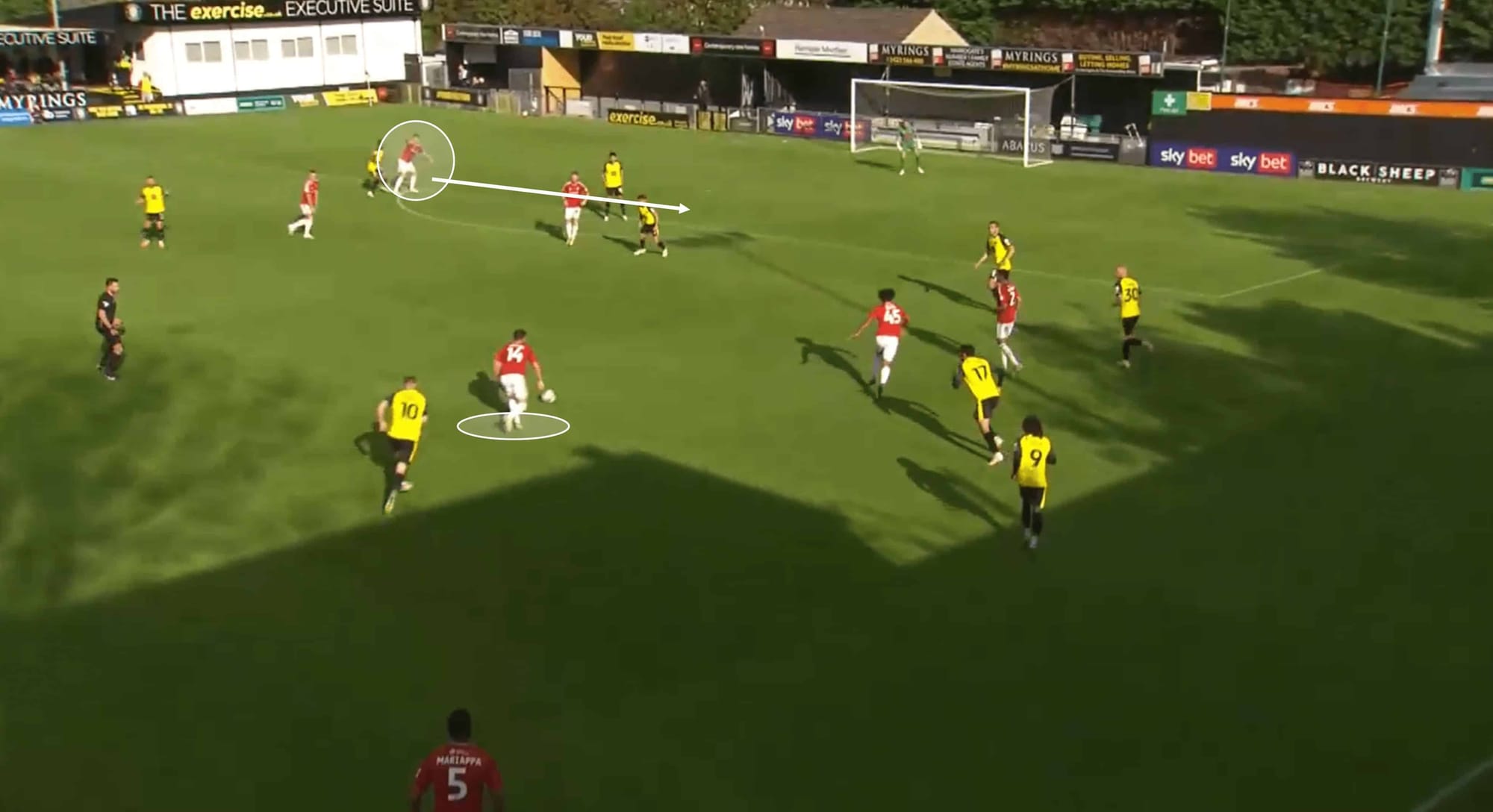
His off-the-ball movement is critical to his success, as it is for any striker – Smith seems to have a natural structure and purpose to his movements, showing good game understanding. When Salford are coming forward, and Smith is prepping himself for a delivery, instead of dropping in to assist the possession as he does in earlier build-up phases, he often looks to sit on the shoulder of the final defender before making a run. The type and direction of the run vary depending on the situation.
In the example above, for instance, he starts on what would be the far side if Salford continued the attack down the centre-right area – something he does often. Still, he makes an inward run toward the centre, looking to receive the ball between defenders, which would be difficult to defend against.
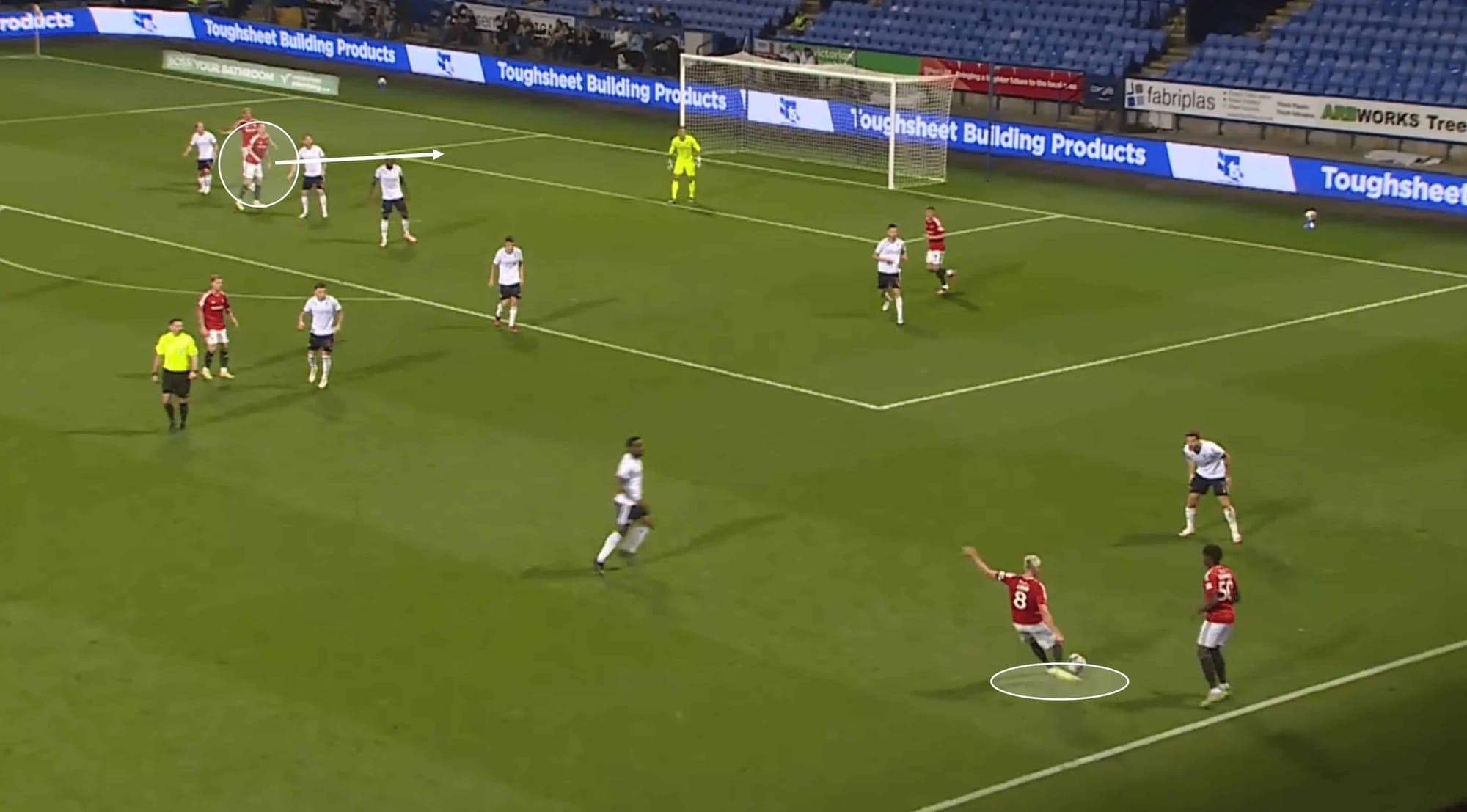
However, other times, particularly when Salford have wide possession, he will look to stay on the far side, anticipating a lofted delivery where he believes he can beat the opposition defender in a duel. While his movements vary depending on several things like teammate positioning, opposition positioning, etc., in the box, he likes to stay on that far side when possible as he seems to prefer heading the ball back towards the goal rather than flicking it on as he would have to if he was on the near side of possession.
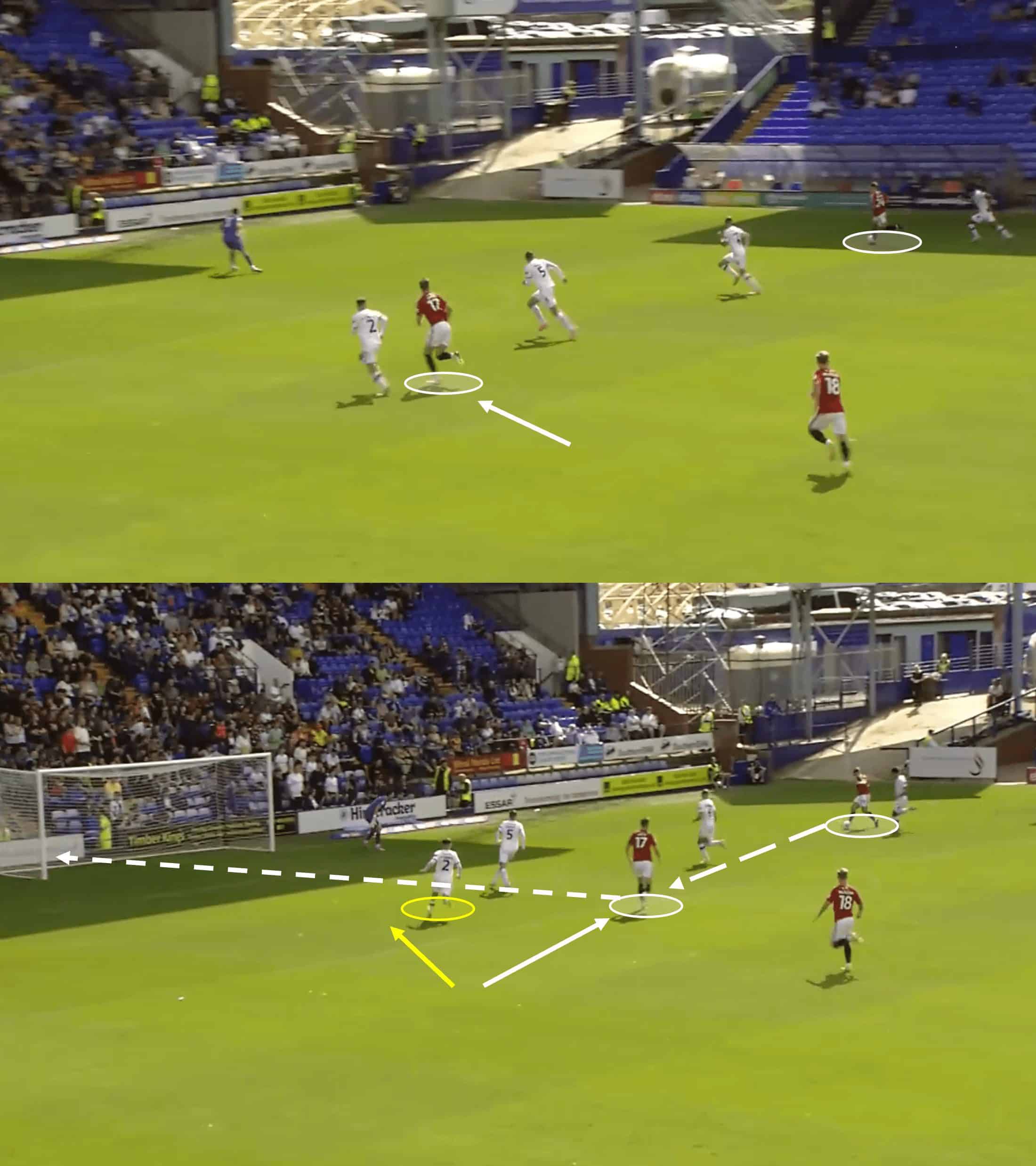
In attacking transitions, Smith is a highly effective player when the move is executed well. While he lacks the pace to carry the counterattack, he is quick enough to get into good supporting positions in the box when the delivery is made.
The example above shows that well. As his teammate on the right flank carries the ball towards the box, Smith runs forward next to the opposition full-back. Instead of continuing his run towards the far post, he drops his shoulder and darts into a central area where he is entirely unmarked. With a simple delivery executed well, he is teed up for a first-time strike on goal – another area where Smith is deadly.
Conclusion
Matt Smith has had a well-travelled EFL career, playing for the likes of Fulham, Millwall, QPR, and Oldham Athletic, to name a few, and is now in his twilight years as a footballer, aged 34 currently. He’s had a respectable track record wherever he has gone, and he could have one of his best seasons this campaign, in terms of goalscoring at least. Salford have their issues in defence, and there are certainly improvements to aim for in possession, too. Still, Neil Wood clearly knows what talent he has at his disposal in Matt Smith and uses him to have an outstanding impact in an attacking system that suits him well.

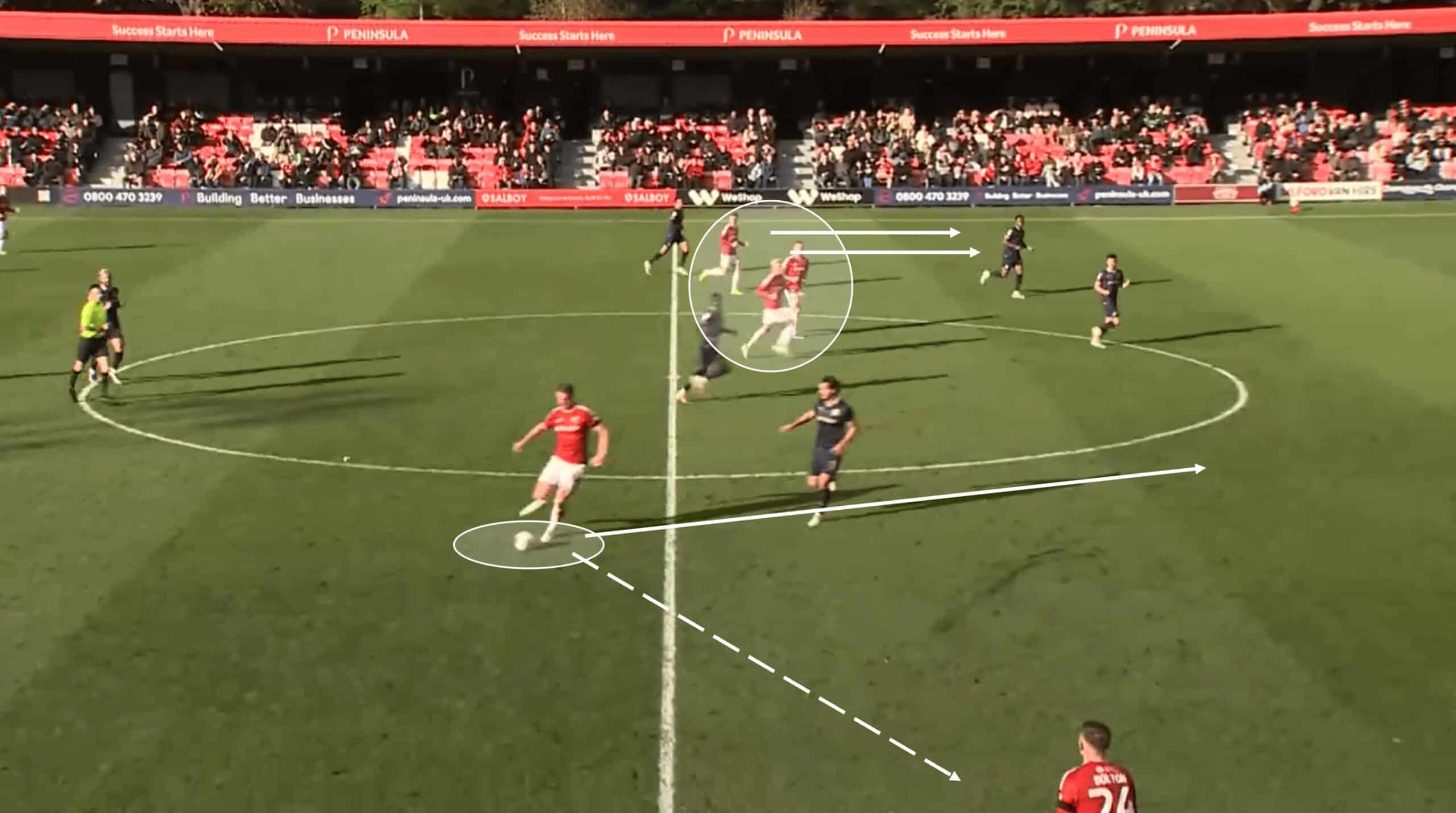




Comments